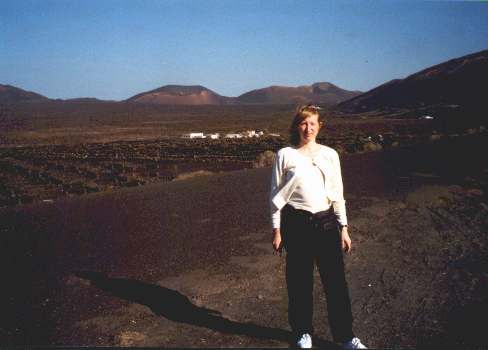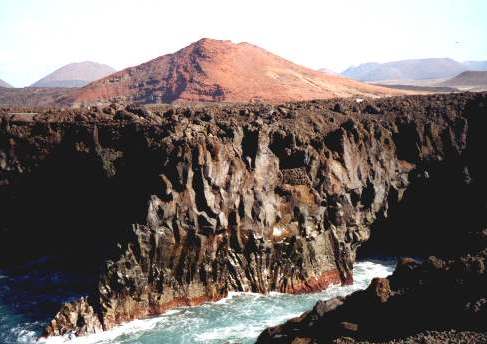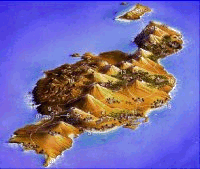Lanzarote is the
most easterly of the seven major Canary Islands and lies in the Atlantic
Ocean only some 100 km from the African coast. The island covers only about
60 km in length and 20 km at its widest point. Its surface of solidified
lava and volcanic rock looks like
a moonscape which was sculpted by the volcanic eruptions between 1730 and
1736. Lanzarote's white houses form a pretty contrast to the black soil.
The island enjoys an average temperature of 22 ºC all year-round.
The former fishing village Playa Blanca, situated at the southernmost tip
of the island, is the smallest and most tranquil of the major tourist resorts.
It has a beach of fine golden sand and a picturesque promenade with a good
view of Fuerteventura. As it is a flourishing resort there's quite a bit
of construction work going on at the moment.
During three days
we rented a car for only 9.300 Pesetas (56 Euros) with Felycar. You can
get even cheaper offers but not including full insurance. On the first
day we drove through the wine region of La Geria. The island's special
way of cultivating wine by planting just one vine each in little craters
of black lava sand sheltered by small black stone walls was declared as
"engineering with engineers" by the Museum
of Modern Art in New York. We strolled around the former capital Teguise
and visited the Fundación César Manrique (1000 Pesetas).
This famous artist built his unique house which is now a museum right into
the lava stones. Afterwards we visited the cave system Jameos de Agua (1000
Pesetas) in the north of Lanzarote. The 'jameos' are natural entrances
to subterranean volcanic pipes, generated by molten lava descending towards
the sea. Inside the grotto is a lake which is the only place in the world
where a species of blind white crab can be found. We surrounded the Malpaís
de la Corona which also offers some patches of white sandy beaches. We
enjoyed the fantastic view onto the islet Isla Graciosa but avoided paying
the entry fee to the viewpoint Mirador del Río also constructed
by César Manrique. We visited Haría in the "valley of a 1000
palm trees". This abundance of green is very rare on Lanzarote. From the
chapel Ermita de las Nieves we had a good view of the steep cliffs of the
north-west coast. We also had a look at the modern windmills in the Parque
Éolico. As it was getting late we headed back to the hotel afterwards,
passing by Femés which offers a good view onto Playa Blanca.
Pesetas).
This famous artist built his unique house which is now a museum right into
the lava stones. Afterwards we visited the cave system Jameos de Agua (1000
Pesetas) in the north of Lanzarote. The 'jameos' are natural entrances
to subterranean volcanic pipes, generated by molten lava descending towards
the sea. Inside the grotto is a lake which is the only place in the world
where a species of blind white crab can be found. We surrounded the Malpaís
de la Corona which also offers some patches of white sandy beaches. We
enjoyed the fantastic view onto the islet Isla Graciosa but avoided paying
the entry fee to the viewpoint Mirador del Río also constructed
by César Manrique. We visited Haría in the "valley of a 1000
palm trees". This abundance of green is very rare on Lanzarote. From the
chapel Ermita de las Nieves we had a good view of the steep cliffs of the
north-west coast. We also had a look at the modern windmills in the Parque
Éolico. As it was getting late we headed back to the hotel afterwards,
passing by Femés which offers a good view onto Playa Blanca.
 On the second day
we went to the Playa de Janubio, a beautiful beach of black lava sand at
Lanzarote's west coast. Then we explored the spectacular coastline of Los
Hervideros where the surf rushes in and out of the openings and cracks
formed by lava rock. El Golfo is
a green lagoon inside an ancient volcanic crater, colouring caused by the
algae that inhabit its waters. We stopped in Yaiza, one of the prettiest
villages of Lanzarote, on our way to the Parque
Nacional de Timanfaya, the most extensive
volcanic region of Lanzarote with more than 100 volcanoes. The entry fee
of 1000 Pesetas included a coach tour through the Montañas del Fuego
or Fire Mountains. We had the opportunity to glance into several craters
from the top. The restaurant El Diablo serves meals grilled over geothermal
heat. Even near the surface the temperature rises to 400°C ! As a show
for the tourists water is poured into some holes in the ground causing
a geyser to erupt with a hissing noise. You can also ride a camel through
this area but we didn't. We continued our tour passing through the villages
of Mancha Blanca, Tinajo and Tiagua, the latter with a picturesque old
windmill. We drove as far as La Caleta and the Playa de Famara, a surfing
area, then returned to the hotel.
On the second day
we went to the Playa de Janubio, a beautiful beach of black lava sand at
Lanzarote's west coast. Then we explored the spectacular coastline of Los
Hervideros where the surf rushes in and out of the openings and cracks
formed by lava rock. El Golfo is
a green lagoon inside an ancient volcanic crater, colouring caused by the
algae that inhabit its waters. We stopped in Yaiza, one of the prettiest
villages of Lanzarote, on our way to the Parque
Nacional de Timanfaya, the most extensive
volcanic region of Lanzarote with more than 100 volcanoes. The entry fee
of 1000 Pesetas included a coach tour through the Montañas del Fuego
or Fire Mountains. We had the opportunity to glance into several craters
from the top. The restaurant El Diablo serves meals grilled over geothermal
heat. Even near the surface the temperature rises to 400°C ! As a show
for the tourists water is poured into some holes in the ground causing
a geyser to erupt with a hissing noise. You can also ride a camel through
this area but we didn't. We continued our tour passing through the villages
of Mancha Blanca, Tinajo and Tiagua, the latter with a picturesque old
windmill. We drove as far as La Caleta and the Playa de Famara, a surfing
area, then returned to the hotel.
 On
the third day we visited the tourist resorts of Costa Teguise and Puerto
del Carmen and also passed through the capital Arrecife. The architecture
of Costa Teguise goes back to plans by César Manrique and its main
beach Playa de las Cucharas offers white sand. In contrast to all the rest
of the island the traffic along the promenade in Arrecife was quite heavy
and there was no parking available, so we didn't stop. Puerto del Carmen
is the biggest and oldest tourist place and offers everything the fun-seeking
tourist requires. It has a pretty promenade and the longest beaches of
the island. In the afternoon we got back to Playa Blanca and continued
towards the nearby Playas de Papagayo, several pretty coves with fine white
sand which are only accessible for 500 Pesetas via a dirt road, but they
are well worth it. They are also unofficial nudist beaches and the cliffs
above offer a fantastic view of Playa Blanca and Fuerteventura or the south-east
coast on the other side. You can also rent a mountain bike in Playa Blanca
or take a boat to visit the beaches. Unfortunately new hotel and apartment
complexes are rising in the vicinity of the beaches which therefore might
not remain secluded very much longer.
On
the third day we visited the tourist resorts of Costa Teguise and Puerto
del Carmen and also passed through the capital Arrecife. The architecture
of Costa Teguise goes back to plans by César Manrique and its main
beach Playa de las Cucharas offers white sand. In contrast to all the rest
of the island the traffic along the promenade in Arrecife was quite heavy
and there was no parking available, so we didn't stop. Puerto del Carmen
is the biggest and oldest tourist place and offers everything the fun-seeking
tourist requires. It has a pretty promenade and the longest beaches of
the island. In the afternoon we got back to Playa Blanca and continued
towards the nearby Playas de Papagayo, several pretty coves with fine white
sand which are only accessible for 500 Pesetas via a dirt road, but they
are well worth it. They are also unofficial nudist beaches and the cliffs
above offer a fantastic view of Playa Blanca and Fuerteventura or the south-east
coast on the other side. You can also rent a mountain bike in Playa Blanca
or take a boat to visit the beaches. Unfortunately new hotel and apartment
complexes are rising in the vicinity of the beaches which therefore might
not remain secluded very much longer.
The remaining days
of our holiday we spent at the pool or walking around Playa Blanca. The
heated pool wasn't too cold but we didn't swim in the sea, quite a few
people did though. Once we also had lunch in a restaurant on Playa Blanca's
pretty promenade tasting the famous salty potatoes "papas arrugadas" and
a tortilla (Spanish omlette). The sun was shining every day. Only two days
were a bit cloudy and in the evening it cooled down a fair bit. The steady
wind could turn quite cold when there was no sun. On the day of our departure
it was raining very hard, so we had picked the right day!





 Pesetas).
This famous artist built his unique house which is now a museum right into
the lava stones. Afterwards we visited the cave system Jameos de Agua (1000
Pesetas) in the north of Lanzarote. The 'jameos' are natural entrances
to subterranean volcanic pipes, generated by molten lava descending towards
the sea. Inside the grotto is a lake which is the only place in the world
where a species of blind white crab can be found. We surrounded the Malpaís
de la Corona which also offers some patches of white sandy beaches. We
enjoyed the fantastic view onto the islet Isla Graciosa but avoided paying
the entry fee to the viewpoint Mirador del Río also constructed
by César Manrique. We visited Haría in the "valley of a 1000
palm trees". This abundance of green is very rare on Lanzarote. From the
chapel Ermita de las Nieves we had a good view of the steep cliffs of the
north-west coast. We also had a look at the modern windmills in the Parque
Éolico. As it was getting late we headed back to the hotel afterwards,
passing by Femés which offers a good view onto Playa Blanca.
Pesetas).
This famous artist built his unique house which is now a museum right into
the lava stones. Afterwards we visited the cave system Jameos de Agua (1000
Pesetas) in the north of Lanzarote. The 'jameos' are natural entrances
to subterranean volcanic pipes, generated by molten lava descending towards
the sea. Inside the grotto is a lake which is the only place in the world
where a species of blind white crab can be found. We surrounded the Malpaís
de la Corona which also offers some patches of white sandy beaches. We
enjoyed the fantastic view onto the islet Isla Graciosa but avoided paying
the entry fee to the viewpoint Mirador del Río also constructed
by César Manrique. We visited Haría in the "valley of a 1000
palm trees". This abundance of green is very rare on Lanzarote. From the
chapel Ermita de las Nieves we had a good view of the steep cliffs of the
north-west coast. We also had a look at the modern windmills in the Parque
Éolico. As it was getting late we headed back to the hotel afterwards,
passing by Femés which offers a good view onto Playa Blanca.  On the second day
we went to the Playa de Janubio, a beautiful beach of black lava sand at
Lanzarote's west coast. Then we explored the spectacular coastline of Los
Hervideros where the surf rushes in and out of the openings and cracks
formed by lava rock. El Golfo is
a green lagoon inside an ancient volcanic crater, colouring caused by the
algae that inhabit its waters. We stopped in Yaiza, one of the prettiest
villages of Lanzarote, on our way to the
On the second day
we went to the Playa de Janubio, a beautiful beach of black lava sand at
Lanzarote's west coast. Then we explored the spectacular coastline of Los
Hervideros where the surf rushes in and out of the openings and cracks
formed by lava rock. El Golfo is
a green lagoon inside an ancient volcanic crater, colouring caused by the
algae that inhabit its waters. We stopped in Yaiza, one of the prettiest
villages of Lanzarote, on our way to the  On
the third day we visited the tourist resorts of Costa Teguise and Puerto
del Carmen and also passed through the capital Arrecife. The architecture
of Costa Teguise goes back to plans by César Manrique and its main
beach Playa de las Cucharas offers white sand. In contrast to all the rest
of the island the traffic along the promenade in Arrecife was quite heavy
and there was no parking available, so we didn't stop. Puerto del Carmen
is the biggest and oldest tourist place and offers everything the fun-seeking
tourist requires. It has a pretty promenade and the longest beaches of
the island. In the afternoon we got back to Playa Blanca and continued
towards the nearby Playas de Papagayo, several pretty coves with fine white
sand which are only accessible for 500 Pesetas via a dirt road, but they
are well worth it. They are also unofficial nudist beaches and the cliffs
above offer a fantastic view of Playa Blanca and Fuerteventura or the south-east
coast on the other side. You can also rent a mountain bike in Playa Blanca
or take a boat to visit the beaches. Unfortunately new hotel and apartment
complexes are rising in the vicinity of the beaches which therefore might
not remain secluded very much longer.
On
the third day we visited the tourist resorts of Costa Teguise and Puerto
del Carmen and also passed through the capital Arrecife. The architecture
of Costa Teguise goes back to plans by César Manrique and its main
beach Playa de las Cucharas offers white sand. In contrast to all the rest
of the island the traffic along the promenade in Arrecife was quite heavy
and there was no parking available, so we didn't stop. Puerto del Carmen
is the biggest and oldest tourist place and offers everything the fun-seeking
tourist requires. It has a pretty promenade and the longest beaches of
the island. In the afternoon we got back to Playa Blanca and continued
towards the nearby Playas de Papagayo, several pretty coves with fine white
sand which are only accessible for 500 Pesetas via a dirt road, but they
are well worth it. They are also unofficial nudist beaches and the cliffs
above offer a fantastic view of Playa Blanca and Fuerteventura or the south-east
coast on the other side. You can also rent a mountain bike in Playa Blanca
or take a boat to visit the beaches. Unfortunately new hotel and apartment
complexes are rising in the vicinity of the beaches which therefore might
not remain secluded very much longer.